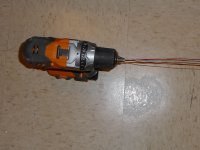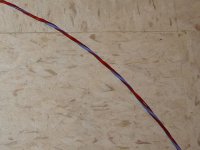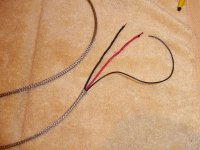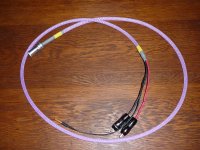About two months ago I built a phono cable that I thought would sound pretty good. It was based on discoveries I had made over the course of time with principles that I knew worked.
1. Phono signals are tiny and need smaller wire
2. Bass does not come out forcefully enough if there is not enough wire to carry the return signal
3. Phono cables need real shielding (I have tried lots materials with little success)
4. Rectangular solid core wire renders exceptional clarity
I got better than expected results and wanted to share them with the community. If we go basic you can build this cable for under $150.00 and it sounds fantastic. This basic version actually sounds better than any cable I have heard for under $700.00! Below is a list of what you will need to build a four foot cable. These ingredients are available at Partsconnexion and CryoParts. There are lots of variables out there, experiment with your favorite RCA ends or DIN connectors.
[Disclaimer: This is a basic version of the cable that I will be offering on Cryo-Parts.com I do a little extra voodoo on mine that bring the performance up a notch, I am not sharing that - as my secret sauces would not be secret anymore]
8ft 22 AWG Legenburg rectangular wire for the return lead (I use 4ft blue and 4ft red to make it easy to identify polarity)
8ft 24 AWG Legenburg rectangular wire for the live lead (I strip back one lead to identify it for polarity)
1ea DIN connector (the Cardas S DIN E is the least expensive quality connector)
4ft tinned ¼” copper braid
4ft Techflex PET (I like to use ¼” as it expands so much and give a cool see through appearance)
1 piece of 3/8” heat shrink
2 pieces of 1/4” shrink (for RCA end)
2ea RCA ends (I like minimalist connectors where the pins are small- remember the signal is tiny- the CryoParts MPS is the least expensive of this type I know of. Other options are Eichmann and WBT Nextgen- personally and for my customers I use modified AQ 800’s. We are not a dealer for AQ but when these are modified they are quite nice)
If you go with the least expensive good parts it will be less than $150.00
Below is a step by step process for making a terrific phono cable yourself.
1. Cut the wire into equal lengths (I like to mark one of the wires by cutting back the Teflon as marker will not stick)
2. Tape the ends so the wires are sort of squished together
3. Put one end in a vice and the other in a hand held drill
4. Slowly turn on the drill and let it spin until you have a nice twist- these are solid core wires and will retain the twist when released
5. Twist the single Pos and Neg run into a Y that will go into your preamp via RCA
6. Put the tinned shield over the cable and trim to size
7. Pull out a little group of the shield strands and solder
8. Solder a short wire on the DIN end and a longer ground wire on the RCA end
9. Put the heat shrink over your Y connector wires- hopefully a different color for + and -
10. Pull the Techflex PET over the shield
11. Put the heatshrink on the ends of the main body
12. Solder on the connectors
I decide to have a little fun with mine, my Vikings are much improved this year and their colors are purple and gold. I used purple PET and put a yellow band around the retaining shrink- if you can’t have fun with your stereo… who can?
1. Phono signals are tiny and need smaller wire
2. Bass does not come out forcefully enough if there is not enough wire to carry the return signal
3. Phono cables need real shielding (I have tried lots materials with little success)
4. Rectangular solid core wire renders exceptional clarity
I got better than expected results and wanted to share them with the community. If we go basic you can build this cable for under $150.00 and it sounds fantastic. This basic version actually sounds better than any cable I have heard for under $700.00! Below is a list of what you will need to build a four foot cable. These ingredients are available at Partsconnexion and CryoParts. There are lots of variables out there, experiment with your favorite RCA ends or DIN connectors.
[Disclaimer: This is a basic version of the cable that I will be offering on Cryo-Parts.com I do a little extra voodoo on mine that bring the performance up a notch, I am not sharing that - as my secret sauces would not be secret anymore]
8ft 22 AWG Legenburg rectangular wire for the return lead (I use 4ft blue and 4ft red to make it easy to identify polarity)
8ft 24 AWG Legenburg rectangular wire for the live lead (I strip back one lead to identify it for polarity)
1ea DIN connector (the Cardas S DIN E is the least expensive quality connector)
4ft tinned ¼” copper braid
4ft Techflex PET (I like to use ¼” as it expands so much and give a cool see through appearance)
1 piece of 3/8” heat shrink
2 pieces of 1/4” shrink (for RCA end)
2ea RCA ends (I like minimalist connectors where the pins are small- remember the signal is tiny- the CryoParts MPS is the least expensive of this type I know of. Other options are Eichmann and WBT Nextgen- personally and for my customers I use modified AQ 800’s. We are not a dealer for AQ but when these are modified they are quite nice)
If you go with the least expensive good parts it will be less than $150.00
Below is a step by step process for making a terrific phono cable yourself.
1. Cut the wire into equal lengths (I like to mark one of the wires by cutting back the Teflon as marker will not stick)
2. Tape the ends so the wires are sort of squished together
3. Put one end in a vice and the other in a hand held drill
4. Slowly turn on the drill and let it spin until you have a nice twist- these are solid core wires and will retain the twist when released
5. Twist the single Pos and Neg run into a Y that will go into your preamp via RCA
6. Put the tinned shield over the cable and trim to size
7. Pull out a little group of the shield strands and solder
8. Solder a short wire on the DIN end and a longer ground wire on the RCA end
9. Put the heat shrink over your Y connector wires- hopefully a different color for + and -
10. Pull the Techflex PET over the shield
11. Put the heatshrink on the ends of the main body
12. Solder on the connectors
I decide to have a little fun with mine, my Vikings are much improved this year and their colors are purple and gold. I used purple PET and put a yellow band around the retaining shrink- if you can’t have fun with your stereo… who can?
Attachments
Last edited:
I really doubt that a cartridge can distinguish which is larger- just like a interconnect wire can't... but it works.
Have you ever noticed that on a "typical" RCA connector that the return metal is HUGE compared to the live?... not to mention that some have a connection to the metal cover. By mass that is probably 100 to 1, how does the wire distinguish that?
Actually in my discussions with Carmine Bocchino - he says that up to an 11 to 1 ratio will work fine. (his inexpensive line of silver plated RCA's is $400 per pair... $800 per four)
Have you ever noticed that on a "typical" RCA connector that the return metal is HUGE compared to the live?... not to mention that some have a connection to the metal cover. By mass that is probably 100 to 1, how does the wire distinguish that?
Actually in my discussions with Carmine Bocchino - he says that up to an 11 to 1 ratio will work fine. (his inexpensive line of silver plated RCA's is $400 per pair... $800 per four)
how does the wire distinguish that?
Mine appears to be quite inert and unresponsive. I've even tried shaking and slapping it, to no avail- it still seems to lack consciousness. Perhaps if I use a square cross section, it might result in sentience?
renders exceptional clarity
[Disclaimer: This is a basic version of the cable that I will be offering on Cryo-Parts.com I do a little extra voodoo on mine that bring the performance up a notch, I am not sharing that - as my secret sauces would not be secret anymore]
Hi Wire Nut,
I'm interested in buying your "special one" - but which particular product is it on Cryo-Parts.com? (I can only see the “Frugal” Tonearm Cable.
Secondly, yes, I know a) narrow-guage and b) solid-core cable sounds best ... but how does rectangular solid-core wire deliver an advantage?
Thanks,
Andy
(his inexpensive line of silver plated RCA's is $400 per pair... $800 per four)
inexpensive?
Where I am (Africa), I can buy a small second-hand car with that money.
inexpensive?
Where I am (Africa), I can buy a small second-hand car with that money.
I can't even buy an HDMI cable for what my car is worth!
Give it a little jolt of electricity, it will come around
" 'Ello, Polly!"
The capacitance is too low to measure on my Fluke 111 multimeter.
Since this is one of the three most important aspects of a phono cable (along with shielding and tribo-induced noise) and you have specs and measurements for none of them, I'm frankly astonished that you're actually selling this stuff. Of course, the fact that this is a "cryo-parts" product should serve as warning that we're dealing with fantasy.
And the Vikings are in a race with the Bears for last place, so there's that.
" 'Ello, Polly!"
I'm frankly astonished that you're actually selling this stuff. Of course, the fact that this is a "cryo-parts" product should serve as warning that we're dealing with fantasy.
I think someone needs to start vintage dating wire.
I really doubt that a cartridge can distinguish which is larger- just like a interconnect wire can't... but it works.
Have you ever noticed that on a "typical" RCA connector that the return metal is HUGE compared to the live?... not to mention that some have a connection to the metal cover. By mass that is probably 100 to 1, how does the wire distinguish that?
Actually in my discussions with Carmine Bocchino - he says that up to an 11 to 1 ratio will work fine. (his inexpensive line of silver plated RCA's is $400 per pair... $800 per four)
Yeah if the ratio gets larger you get signal bunching. Since the same current flows through the the signal and the return wire (that's why it is called 'return' wire of course - sorry for a bit of off-topic tech info) the signal speeds up once it enters the return path and starts to 'bunch' at the ground connection of the plug.
Signal bunching is easily heard by anyone with good ears; it gives a sort of 'staccato' quality to the reproduction. Some actually prefer it to a smooth flow which can quickly become boring.
Good that finally someone takes care of this issue.
Jan
SY- I can't believe you are a moderator on this site. You are the kind of Troll that keeps lurkers lurking with your snide remarks.
When I worked at Best Buy we had guys that mocked Amazon and said they would never amount to anything.
We had guys that mocked the solid core wires from Audio Quest over the stranded Monster cables.
We had guys that mocked the impact online stores would have on the big giant that was Best Buy.
We had one word for them later... unemployed!
When I worked at Best Buy we had guys that mocked Amazon and said they would never amount to anything.
We had guys that mocked the solid core wires from Audio Quest over the stranded Monster cables.
We had guys that mocked the impact online stores would have on the big giant that was Best Buy.
We had one word for them later... unemployed!
- Status
- This old topic is closed. If you want to reopen this topic, contact a moderator using the "Report Post" button.
- Home
- Source & Line
- Analogue Source
- How to build an exceptional Phono Cable cheap



